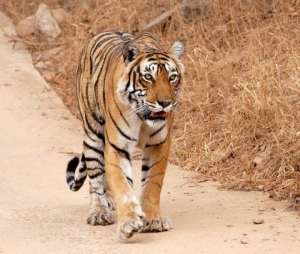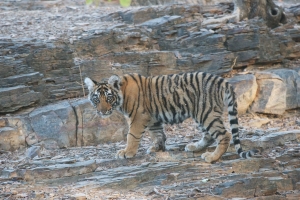Naturalist Stephen Mills talks about the best tiger trip he has ever led
We have been offering specialist tiger safaris to India and Nepal for over 30 years. All of them have been led by tiger naturalist Stephen Mills, who has studied tigers in India since the 1970’s and is author of the BBC book Tiger. His years of filming, studying and researching tiger behaviour greatly enhances your chances of seeing tigers in the wild but working with the Park Authorities and there systems has not always been helpful in our quest. For the last two years the changes in Ranthambhore National Park has revolutionised tiger sightings and the quality of sightings. Stephen Mills talks about the tiger safari he led for us in April 2019 and why it was the best tiger trip has ever led.
” I’m recently home from what was probably the best tiger trip I’ve ever led. Indeed we saw so much – in Ranthambore, in Rajasthan – that had it been one of my old professional filming expeditions I would have been delighted. Numbers tell some of the story. We had 22 sightings of 16 different tigers. We watched a mother with very young cubs. We saw a carefully planned and almost successful hunt and we witnessed a protracted and unusually affectionate mating, involving an ageing female anxious to hold on to her new chap. But what made it really special was the access we were permitted and the intensity of the experience.
Traditional tiger tourist safaris have been sensibly modelled round morning and evening drives, with a rest at your lodge during the heat of the day. But visitor pressure on all the best parks has seen the introduction of increasingly stringent regulations – time limits, early exits and very restrictive prescribed routes – all of which mitigate against the chance of actually tracking and finding a tiger. You may bump into one but that relies mainly on luck not skill.
For years, Ranthambhore was on the bottom of my visiting list: too close to Delhi and Agra, too crowded, too much catering for uncommitted tourists. But things have changed. Despite overwhelming evidence that tiger tourism, whatever its drawbacks, provides essential protection to wild tigers, India’s Forest Departments seem mostly indifferent or hostile to the needs and expectations of visitors. But Rajasthan is a tourist state and the authorities are doing a good job of opening up Ranthambhore. At the same time, and I believe consequently, tiger numbers are soaring there. Currently, specially accredited visitors, guided by a known expert, can apply for all-day, go anywhere, permits. These give you the freedom to track your tigers across the whole park, to sit quietly, all day if need be, waiting for an event to develop – just as I would if I were filming – and best of all, to discover things.
For instance it seems that some tigers now use the hottest hours to hunt. We always regarded these as dead times when you were unlikely to see anything. Deer, monkeys, tigers and tourists were all flat out fanning themselves. But now, these quiet hours, from 10 till 3, when hardly any jeeps are in the park, seem to be providing the tigers with an opportunity. We’ve discovered at least one wily female who repeatedly cools off in the water before making quick attacks on hot, unwary deer. Last year she killed a sambar right beside us after chasing it for more than half a mile. Incredible in 40 degree heat.
So, there we were, just one jeep, with 4 full day and several half day permits, free to roam the whole park. If we wanted solitude we could slip off to a favoured river bed and have lunch beside a waiting tiger, or settle in the shade looking out over the picturesque fort and its lakes bustling with ibis and egrets. What a privilege. I know this must have been an expensive trip for the clients but…I know it’s not really for me to say, but when I got home I thought, even billionaires couldn’t have bought a better experience. We had great harmony in the jeep, an extremely capable, humorous and authoritative local guide, a brilliant driver (very important that) and the full-time focus of myself. And our results were no accident.
One evening, full of the magic of the day’s experience, but probably tired from the long heat, we got stuck in a jam on the exit road. Vehicles were stacked up like the M25. When we finally reached poll position we saw that all attention was fixed on a little shrine, far away on the peak of a hill. Prancing lithely on the top of the shrine were two very amorous leopards. This was a gentle reminder that, in a land of 1.3 billion people, solitude can be an elusive and expensive commodity.”
c Stephen Mills 2019
Stephen Mills,
Wildlife Research, Journalism, Photo
If you would like to join Stephen Mills on a tiger safari then please contact us +44 (0)1825714310
info@spencerscott.co.uk.
Images: Simon Pettit and Adrian Brooker – guests who travelled with Stephen Mills April 2019










